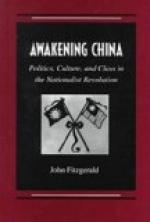There are, however, three other inventions or improvements of the known arts, which deserve notice in this connection, namely, the “three Ps”—pen, paper and printing—all preeminently instruments of peaceful culture. The pen in China is a hair pencil resembling a paint-brush. It was invented by Mung-tien in the third century B. c. Paper was invented by Tsai Lun, 100 B. c., and printing by Fungtao in the tenth century of the present era. What is meant by printing in this case is, however, merely the substitution of wood for stone, the Chinese having been for ages in the habit of taking rubbings from stone inscriptions. It was not long before they divided the slab into movable characters and earned for themselves the honour of having anticipated Gutenberg and Faust. Their divisible types were never in general use, however, and block printing continues in vogue; but Western methods are rapidly supplanting both.
The three states were reunited under the Tsin dynasty, 265 A. D. This lasted for a century and a half and then, after a succession of fifteen emperors, went down in a sea of anarchy, from the froth of which arose more than half a score of contending factions, among which four were sufficiently prominent to make for themselves a place in history. Their period is described as that of the Nan-peh Chao, “Northern and Southern Kingdoms.” The names of the principals were Sung, Wei, Liang and Chin. The first [Page 117] only was Chinese, the others belonging to various branches of the Tartar race. The chiefs of the Liang family were of Tibetan origin—a circumstance which may perhaps account for their predilection for Buddhism. The second emperor of that house, Wu Ti, became a Buddhist monk and retired to a monastery where he lectured on the philosophy of Buddhism. He reminds one of Charles the Fifth, who in his retirement amused himself less rationally by repairing watches and striving, in vain, to make a number of them keep identical time.
It may be noted that behind these warring factions there is in progress a war of races also. The Tartars are forever encroaching on the Flowery Land. Repulsed or expelled, they return with augmented force; and even at this early epoch the shadow of their coming conquest is plainly visible.




